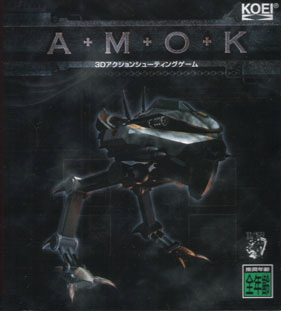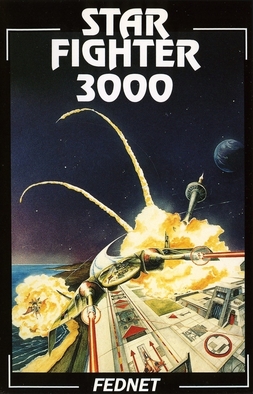
Virtua Cop is a 1994 light gun shooter game developed by Sega AM2 and designed by Yu Suzuki. It was originally an arcade game on the Sega Model 2 system, and was ported to the Sega Saturn in 1995 and Windows in 1996. The Saturn version included support for both the Virtua Gun and Saturn mouse, as well as a new "Training Mode" which consists of a randomly generated shooting gallery.

X-Men: Children of the Atom is a 1994 fighting game developed and published by Capcom and released on the CP System II arcade hardware. It was released in December 1994 in Japan and in January 1995 in North America and Europe.

Hi-Octane is a 1995 vehicular combat and racing video game published by Electronic Arts for MS-DOS, PlayStation, and Sega Saturn. It was developed by Bullfrog Productions based upon their earlier Magic Carpet game code. The tracks are wider and more open than most racing games. Hi-Octane was not as well received as the thematically similar Wipeout by Psygnosis and was criticized for the short view distance. Bullfrog also released an expansion pack with three new tracks and new game modes.

Virtua Fighter 2 is a 1994 fighting video game by Sega. It is the sequel to Virtua Fighter (1993), and the second game in the Virtua Fighter series. Created by Sega's Yu Suzuki-headed AM2 team, it was designed on the purpose-made Sega Model 2 hardware which provided a significant upgrade in graphical capabilities. Following its release on the arcades, Virtua Fighter 2 was ported to the Sega Saturn home console in November 1995, while ports for some other platforms appeared later.

Guardian Heroes is a 2D side-scrolling beat 'em up video game developed by Treasure and released by Sega in 1996 for the Sega Saturn video game console. The game resembles Final Fight or Golden Axe, but with RPG elements. The development team called it a "fighting RPG". A sequel was released in 2004 for the Game Boy Advance entitled Advance Guardian Heroes.
Gungriffon is a series of video games developed by Game Arts and designed by Takeshi Miyaji. Gungriffon and Gungriffon II originally appeared for the Sega Saturn console in 1996, with more recent appearances in Gungriffon Blaze for the PlayStation 2 and Gungriffon: Allied Strike for the Xbox. The Gungriffon games are focused on piloting mecha—large, usually bipedal military vehicles. This game series refers to these machines as Armored Walking Gun Systems (AWGS). With the exception of the High-MACS design, the mecha in this series have a distinctly realistic design philosophy.

F1 Challenge is an officially licensed Formula One game developed by Bell Corporation and produced by Sega for the Sega Saturn. The game contains only three of the many Formula One circuits – Hockenheim, Monte Carlo, and Suzuka – while having another three based on the fictional Neo City, containing three different configurations.

RayForce is a vertically scrolling shooter by Taito for the Taito F3 arcade hardware and released in 1994. It was ported to the Sega Saturn in 1995, Microsoft Windows in 1997, then rereleased for iOS in 2012 and Android in 2017.

Rad Mobile is a racing arcade game developed by Sega AM3 and published by Sega. It was first published in Japan in October 1990, followed by an international release for arcades in February 1991. Rad Mobile was Sega's first 32-bit game, using Sega's System 32 arcade system board. It was also the first ever appearance of Sonic the Hedgehog, who appears as an ornament hanging from the driver's rearview mirror.

MechWarrior 2: 31st Century Combat is a vehicle simulation game developed and published by Activision, released in 1995 as part of the MechWarrior series of video games in the BattleTech franchise. The game is set in 3057, and is played as a tactical simulation that incorporates aspects of real-time first-person combat and the physical simulation of the player's mech. It is a game recreation of the "Refusal War." The player can join one of the clans, Clan Jade Falcon or Clan Wolf while engaging in up to 32 missions.

Black Dawn is a helicopter-combat simulation, published by Virgin Interactive Entertainment. It was released on the Sony PlayStation and the Sega Saturn in 1996.

Starblade is a 1991 3D rail shooter arcade game developed and published by Namco. Controlling the starfighter FX-01 "GeoSword" from a first-person perspective, the player is tasked with eliminating the Unknown Intelligent Mechanized Species (UIMS) before they wipe out Earth. Gameplay involves controlling a crosshair with a flight yoke stick and destroying enemies and their projectiles before they inflict damage on the player.

Amok is a 1996 mech-themed action video game for Windows and Sega Saturn. Players guide a robot called "Slambird" through nine different scenarios to complete several objectives. The game was noted for its use of voxel-based graphics for its environments rather than the polygonal models which were standard at the time of its release. Developed by Lemon, Amok began as a technology demo for the Sega 32X, but was reworked for the Saturn after Sega discontinued support for the 32X.

Star Fighter or Star Fighter 3000 is a 3D flight-based shoot-em-up developed and published by UK company Fednet Software, and released in 1994 for the Acorn Archimedes. The gameplay is mission based and involves elements of strategy and planning. The player can order wingmen to fly in formation and attack specific targets.

Independence Day is a combat flight simulator video game based on the 1996 film of the same name. The game was developed by Radical Entertainment and published by Fox Interactive in North America and Electronic Arts internationally for Microsoft Windows, PlayStation and Sega Saturn.

Galaxy Force is a rail shooter video game developed and released by Sega for arcades in 1988. The player assumes control of a starship named the TRY-Z, as it must prevent the Fourth Empire from taking over the entire galaxy. Gameplay involves shooting down enemies using either a laser shot or a limited supply of heat-seeking missiles, all while avoiding collision with projectiles or obstacles and making sure the ship's energy meter doesn't fully deplete. It ran on the Sega Y Board arcade system, and was released with a motion simulator cockpit arcade cabinet version like previous Sega Super Scaler games.

Firestorm: Thunderhawk 2, known as Thunderstrike 2 in North America, is a 1995 combat flight simulation video game developed and published by Core Design for PlayStation, Sega Saturn and MS-DOS. It is the sequel to Thunderhawk AH-73M.
Sky Target is a 1995 arcade game by Sega. A rail shooter featuring a number of planes including the default F-14D Super Tomcat, it is best remembered for its semi-official connection to Sega's earlier hit After Burner. Although never billed as a sequel, its overt similarities to the 1987 classic were nonetheless referenced in official promotional materials and recognized by the media. Plus, it features a revised version of the "After Burner" music theme within its soundtrack.

Ace is a combat flight simulator video game published for the Commodore 64, VIC-20, and Plus/4 in 1985 by Cascade Games. It was ported to the Amstrad CPC, Amstrad PCW, Amiga, and ZX Spectrum.

Black Fire is a 1995 combat flight simulation video game developed by NovaLogic, published in North America by Sega and in Japan and Europe by Virgin Interactive Entertainment for the Sega Saturn.


















